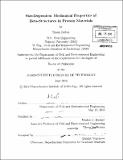Size-dependent mechanical properties of beta-structures in protein materials
Author(s)
Keten, Sinan
DownloadFull printable version (25.34Mb)
Other Contributors
Massachusetts Institute of Technology. Dept. of Civil and Environmental Engineering.
Advisor
Markus J. Buehler.
Terms of use
Metadata
Show full item recordAbstract
Protein materials such as spider silk can be exceptionally strong, and they can stretch tremendously before failure. Notably, silks are made entirely of proteins, which owe their structure and stability to weak molecular interactions, in particular, hydrogen bonds (H-bonds). Beta-structures, a class of protein folds that employ dense arrays of H-bonds, are universal in strong protein materials such as silks, amyloids, muscle fibers and virulence factors. The biological recipe for creating strong, tough materials from weak bonds, however, has so far remained a secret. In this dissertation, size, geometry and deformation rate dependent properties of beta-structures are investigated, in order to provide a link between the nanostructure and mechanics of protein materials at multiple length scales. Large-scale molecular dynamics (MD) simulations show that beta-structures reinforce protein materials such as silk by forming H-bonded crystalline regions that cross-link polypeptide chains. A key finding is that superior strength and toughness can only be achieved if the size of the beta-sheet crystals is reduced to a few nanometers. Upon confinement into orderly nanocrystals, H-bond arrays achieve a strong character through cooperation under uniform shear deformation. Moreover, the size-dependent emergence of a molecular stick-slip failure mechanism enhances toughness of the material. Based on replica-exchange MD simulations, the first representative atomistic model for spider silk is proposed. The computational, bottom-up approach predicts a multi-phase material with beta-sheet nanocrystals dispersed within semi-amorphous domains, where the large-deformation and failure of silk is governed by the beta-structures. These findings explain a wide range of observations from single molecule experiments on proteins, as well as characterization studies on silks. Results illustrate how nano-scale confinement of weak bond clusters may lead to strong, tough polymer materials that self-assemble from common, simple building blocks.
Description
Thesis (Ph. D.)--Massachusetts Institute of Technology, Dept. of Civil and Environmental Engineering, 2010. Cataloged from PDF version of thesis. Includes bibliographical references (p. 199-217).
Date issued
2010Department
Massachusetts Institute of Technology. Department of Civil and Environmental EngineeringPublisher
Massachusetts Institute of Technology
Keywords
Civil and Environmental Engineering.